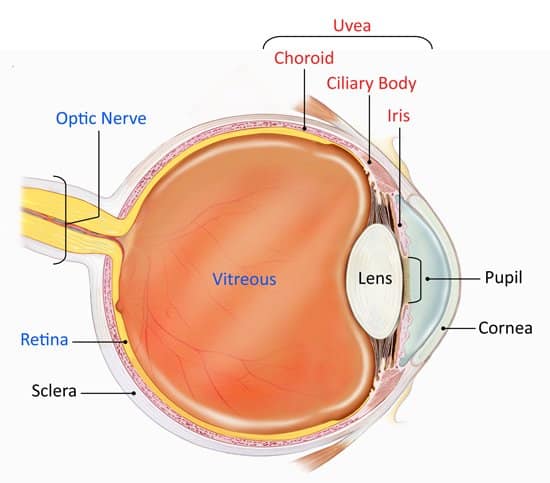
Uveitis Definition
Uveitis (u-ve-I-tis) is inflammation of the uvea, the middle layer of the eye. The uvea consists of the iris, choroid and ciliary body. The choroid is sandwiched between the retina and the white of the eye (sclera), and it provides blood flow to the deep layers of the retina. The most common type of uveitis is an inflammation of the iris called iritis, anterior uveitis. Infections, injury and autoimmune disorders may be associated with the development of uveitis, though the exact cause is often unknown. It can be serious, leading to permanent vision loss. Early diagnosis and treatment are important to prevent the complications.
Uveitis Symptoms
The signs, symptoms and characteristics of uveitis include:
-
- Eye redness
- Eye pain
- Light sensitivity
- Blurred vision
- Dark, floating spots in your field of vision (floaters)
- Decreased vision
- Whitish area (hypopyon) inside the eye in front of the lower part of the coloured area of the eye (iris)
-
- The site of uveitis varies and is described by wherein the eye it occurs
- Anterior uveitis affects the front of your eye, also called iritis.
- Posterior uveitis affects the back of your eye, also called choroiditis.
- Intermediary uveitis affects the ciliary body, also called cyclitis.
- Panuveitis occurs when all layers of the uvea are inflamed.
- In any of these conditions, the jelly-like material in the centre of your eye (vitreous) can also become inflamed and infiltrated with inflammatory cells. Symptoms may occur suddenly and get worse quickly, though in some cases, symptoms develop gradually. Symptoms may be noticeable in one or both eyes.
Uveitis Causes
Sometimes, the specific cause of uveitis is not clear. However, in some people, it is associated with:
- Autoimmune disorders, such as Behcet's disease, sarcoidosis or ankylosing spondylitis.
- Inflammatory disorders, such as Crohn's disease or ulcerative colitis
- Infections such as cat-scratch disease, herpes, syphilis, toxoplasmosis, tuberculosis or West Nile virus
- Eye injury
- Certain cancers, such as lymphoma, that can directly or indirectly affect the eye
Uveitis Risk Factors
Possible risk factors include:
- A genetic predisposition. People with changes in certain genes may be more likely to develop.
- Having an infection. A number of infections, such as toxoplasmosis, cat-scratch fever, tuberculosis, herpes, syphilis and West Nile virus, can increase the risk.
- Having an autoimmune or inflammatory disorder. Conditions that increase the chance of uveitis include Behcet's disease, ankylosing spondylitis, sarcoidosis, psoriatic arthritis, Crohn's disease and ulcerative colitis.
- A history of eye injury. Trauma to the eye can cause uveitis. It's even possible for uveitis to develop in the eye that wasn't injured.

For more information visit our website : https://mumbaieyeretinaclinic.com/

























